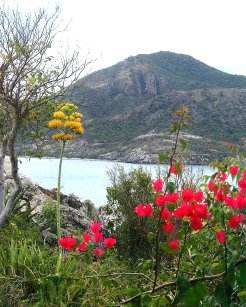
FLORA & FAUNA OF ANTIGUA
MUSEUM OF ANTIGUA & BARBUDA
Collected by D. V. Nicholson
|
|
C O N T E N T S |
|
|
TREES
|
 |
REPTILES |
For "Sounds of the Night" see TREE FROG and the CICADA.
This is the graceful palm of tropic shores, and perhaps the most useful to human kind. It appears to be native as pollen was recorded in Barbados in an Amerindian midden dating 600 AD. The tree has the largest seed in the world. Did you know the palm could be used for the following?
Candles, drinks, wine, copra, oil, alcohol, posts, charcoal, walking sticks, thatch, screens souvenirs, hats, mats, ropes, brooms, brushes, hair oil, laxative, fish poison antidote, vitamin B, skin problems and high blood pressure.
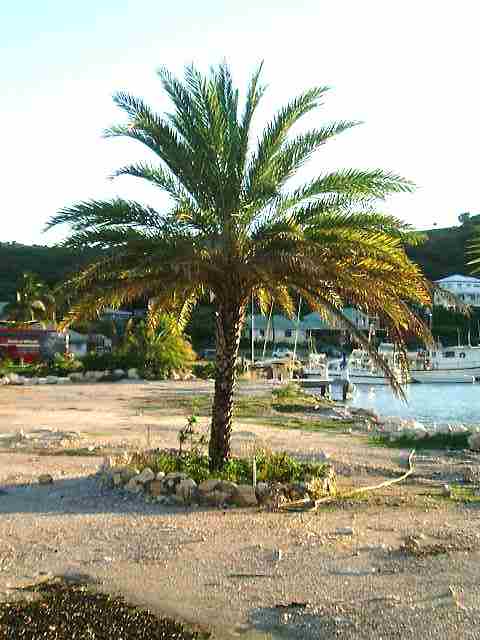 ‘Nega Oil’ is an
Antiguan name and is
very common north of
All Saints village
and may be seen as
transplanted
ornamentals at hotel
developments. This
palm is supposed to
have been introduced
into Freeman’s
Estate from Africa
in colonial times of
the 18th
century. Camels were
introduced as beasts
of burden and these
plants were to be
used as fodder. The
camels died of hoof
disease in the
comparatively damp
soil of Antigua, but
the palms lived on.
The leaves are used
in handcrafts for
weaving hats and
brooms are made.
Children eat the
black seeds, but a
desert climate is
required to produce
dates.
‘Nega Oil’ is an
Antiguan name and is
very common north of
All Saints village
and may be seen as
transplanted
ornamentals at hotel
developments. This
palm is supposed to
have been introduced
into Freeman’s
Estate from Africa
in colonial times of
the 18th
century. Camels were
introduced as beasts
of burden and these
plants were to be
used as fodder. The
camels died of hoof
disease in the
comparatively damp
soil of Antigua, but
the palms lived on.
The leaves are used
in handcrafts for
weaving hats and
brooms are made.
Children eat the
black seeds, but a
desert climate is
required to produce
dates.
Family: Combretaceae
This large tree is
the national tree of
Antigua and Barbuda.
It is commonly found
in a riparian
environment (living
on river banks or
dry river banks in
Antigua). It has
had many uses in the
past and these
include: carts ,
fences,
construction, work
benches, marine
piling, house posts,
charcoal, tanning,
shade, ornamental,
gun carriages,
burning lime and
turning. The resin
was used for swollen
glands, and as a manchioneel
antidote. The timber
is very heavy, hard
and strong., the
inner part being
black. It was used
at the old forts of
Antigua for gun
carriages.
a riparian
environment (living
on river banks or
dry river banks in
Antigua). It has
had many uses in the
past and these
include: carts ,
fences,
construction, work
benches, marine
piling, house posts,
charcoal, tanning,
shade, ornamental,
gun carriages,
burning lime and
turning. The resin
was used for swollen
glands, and as a manchioneel
antidote. The timber
is very heavy, hard
and strong., the
inner part being
black. It was used
at the old forts of
Antigua for gun
carriages.
Family: Bignonaceae
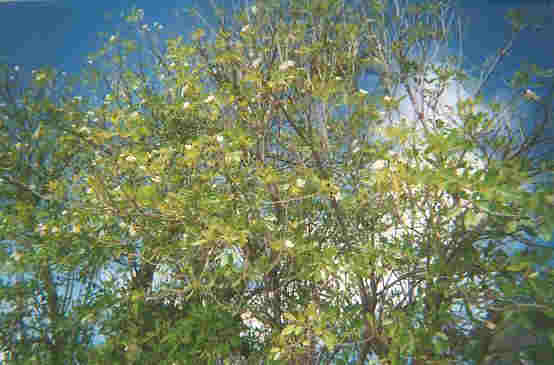 “1676 - There is a
store of timber in
Antigua to effect
ship repair, it is
the timber worm will
not touch, called
White Seeder”. This
small tree with
shiny leaves has
white to purple
flowers and winged
seeds. The wood
carves well for
wooden bowls,
mortars and was used
for Carib canoes. It
is good for grown
knees and
floorboards in boat
building. The bark
of the tree cures
corns and the
chopped leaves are
good for poultices.
“1676 - There is a
store of timber in
Antigua to effect
ship repair, it is
the timber worm will
not touch, called
White Seeder”. This
small tree with
shiny leaves has
white to purple
flowers and winged
seeds. The wood
carves well for
wooden bowls,
mortars and was used
for Carib canoes. It
is good for grown
knees and
floorboards in boat
building. The bark
of the tree cures
corns and the
chopped leaves are
good for poultices.
A
tree of the Borage family.
During the colonial period, many exotic species were introduced to Antigua for their aesthetic and practical values. The Tamarind provided shade and was resistant to drought, and produced an edible fruit. The Cordia was also highly resistant to drought, produced a valuable hardwood and was constantly in flower. Both were planted around sugar estates, particularly close to the houses and along the roads and paths where shade was needed.
A small tree with spreading leaf-covered branches and large green oval fruits, which when ripe have hard dry walls. It is a native of the West Indies. The inside pulp is useless, except as an abortive in cattle. You may cut the fruit in half when green, hollow out with a spoon and scratch designs in the soft green skin. When dry, these designs will contrast well and be permanent. The fruits make bailers and maracas shak-shaks. The plant was also used for skin diseases
Family Bombacaceae
SILK COTTON TREE, Ceiba pentandra (L) Gaertner.
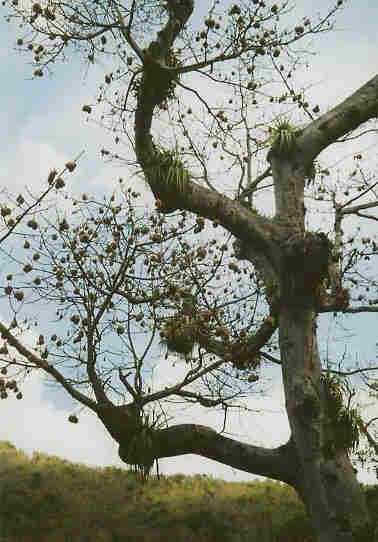 This
large tree is also
known as the Kapoc
Tree. Kapoc is the
floss around its
seeds, which is used
for its dispersal,
and was once used
for filling life
jackets as it is
buoyant. A hundred
pods made 1 lb of
floss; it was a
large export of
Java. In Antigua
this tree once had a
spiritual
significance and was
known as the "Home
of Tree Spirits". In
Montserrat, wooden
coffins made from
this tree were once
hung on fruit trees
to prevent theft.
The Amerindians once
used this large tree
for carving out
their canoes. Other
uses have been for
stuffing mattresses,
making drums, oils,
used as a vegetable,
a bath to prevent
fatigue, to
counteract poison
and used against
colic, inflammation
and to cure ulcers
and coughs.
This
large tree is also
known as the Kapoc
Tree. Kapoc is the
floss around its
seeds, which is used
for its dispersal,
and was once used
for filling life
jackets as it is
buoyant. A hundred
pods made 1 lb of
floss; it was a
large export of
Java. In Antigua
this tree once had a
spiritual
significance and was
known as the "Home
of Tree Spirits". In
Montserrat, wooden
coffins made from
this tree were once
hung on fruit trees
to prevent theft.
The Amerindians once
used this large tree
for carving out
their canoes. Other
uses have been for
stuffing mattresses,
making drums, oils,
used as a vegetable,
a bath to prevent
fatigue, to
counteract poison
and used against
colic, inflammation
and to cure ulcers
and coughs.
Family: Euphorbiacea
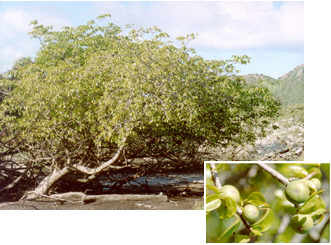 This large poisonous
tree grows commonly
behind Antigua’s
beaches. The fruit
resembles a small
green apple; it is
poisonous, so don’t
sample it! The
Caribs took the
white sap of a
broken twig and
spread it on their
arrowheads as
poison. An immediate
antidote is
seawater. Do not
touch any part of
the tree, or stand
under it in the
rain.
This large poisonous
tree grows commonly
behind Antigua’s
beaches. The fruit
resembles a small
green apple; it is
poisonous, so don’t
sample it! The
Caribs took the
white sap of a
broken twig and
spread it on their
arrowheads as
poison. An immediate
antidote is
seawater. Do not
touch any part of
the tree, or stand
under it in the
rain.
Family: Legume/Caesalpinia
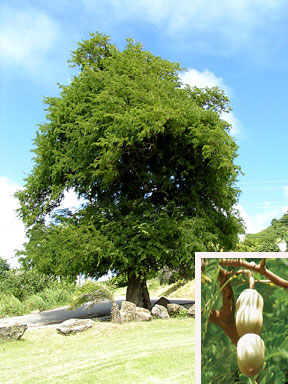 This large shady
tree grows to a
great age and
is a native of
Africa although it
was
introduced from
India. The
generic name is
derived from the
Arabic 'tamar-Hindi',
Indian date.
Its seeds are
surrounded with a
sticky brown pulp
and was used in
former times as a
laxative. They
are an important
source of vitamin C
and a tart soft
drink is still made
from the tamarind in
Antigua. The fruits
are also used for
making chutney.
The timber is dark,
hard and durable and
is used to make all
kinds of implements.
This large shady
tree grows to a
great age and
is a native of
Africa although it
was
introduced from
India. The
generic name is
derived from the
Arabic 'tamar-Hindi',
Indian date.
Its seeds are
surrounded with a
sticky brown pulp
and was used in
former times as a
laxative. They
are an important
source of vitamin C
and a tart soft
drink is still made
from the tamarind in
Antigua. The fruits
are also used for
making chutney.
The timber is dark,
hard and durable and
is used to make all
kinds of implements.
Family: Moraceae
BREADFRUIT, Artocarpus altilus (Park) Fosberg
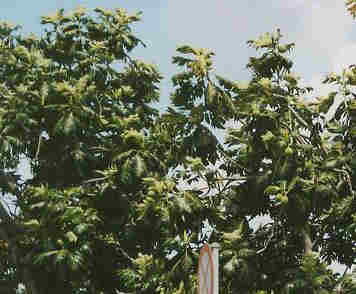 After
the famous mutiny,
Captain Bligh in
1789, brought 1,000
young breadfruit
trees to St. Vincent
in the West Indies.
They were
specifically useful
as a source of slave
food. The leaves are
decorative, deeply
pinnately lobed, and
about 70 by 40 cms.
long. The breadfruit
begins to fruit when
five years old and
continues to bear
for 60-70 years. The
seedless forms can
be boiled and made
into soup. When
roasted they supply
a flour for baking
bread. Unripe fruits
can be dried, cut in
slices and baked to
make biscuits which
can be stored for
future use. The bark
of the tree produces
a fibre which has
been used for
weaving and binding,
and the timber was
employed for boat
building.
Medicinally the
Breadfruit has been
used for lowering
blood pressure,
heart trouble,
headaches,
hypertension, and
urination.
After
the famous mutiny,
Captain Bligh in
1789, brought 1,000
young breadfruit
trees to St. Vincent
in the West Indies.
They were
specifically useful
as a source of slave
food. The leaves are
decorative, deeply
pinnately lobed, and
about 70 by 40 cms.
long. The breadfruit
begins to fruit when
five years old and
continues to bear
for 60-70 years. The
seedless forms can
be boiled and made
into soup. When
roasted they supply
a flour for baking
bread. Unripe fruits
can be dried, cut in
slices and baked to
make biscuits which
can be stored for
future use. The bark
of the tree produces
a fibre which has
been used for
weaving and binding,
and the timber was
employed for boat
building.
Medicinally the
Breadfruit has been
used for lowering
blood pressure,
heart trouble,
headaches,
hypertension, and
urination.
Family: Meliaceae
This
tree a native of India, having been introduced into to Western Hemisphere in
relatively late years. It was probably not in use during colonial times. It is a
fast growing tree and suits a dry climate. It has been used for a variety
of home remedies, and is considered a very valuable plant. It is also useful as
an insecticide when prepared properly. Other uses have been for fevers, women in
pregnancy, blood pressure and chronic rheumatism.
A Mill Reef member, Mr. Brookes Spencer is said to have introduced Neem trees into Antigua at Mill Reef in 1955. They have blossomed ever since. This tree should be planted more in Antigua to prevent further desertification in certain areas. Other uses of this tree past and present are: Home remedies from the bark, oil from the seeds, an insecticide and to counter high blood pressure and diabetes.
Family: Nyctaginaceae. The Four o’Clocks
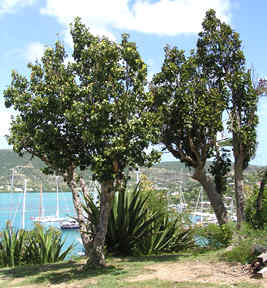 A
very common tree
indeed in Antigua,
mainly because it is
not used for
charcoal burning, or
eaten by goats. The
wood is not used as
timber as it is too
soft and unworkable.
It has been used,
however, as net
floats, box wood,
and as a land crab
purge also as a
water settler in the
buckets of
water-carriers.
A
very common tree
indeed in Antigua,
mainly because it is
not used for
charcoal burning, or
eaten by goats. The
wood is not used as
timber as it is too
soft and unworkable.
It has been used,
however, as net
floats, box wood,
and as a land crab
purge also as a
water settler in the
buckets of
water-carriers.
'Burgoo' or 'Loblolly' was a slave food of maize, pounded, and boiled in water and thickened; very plain and good for nothing. As the tree had so few uses, presumably it was named after the food!.
Family: Burseraceae
The trunk of this tree exudes a resin and the colour of the peeling bark is light brown, hence other names include Birch Gum, Naked Indian and Sun Burnt Tourist. Turpentine is not derived from this tree, but its resin tastes like similar to it. The resin has been employed in home remedies and as glue, varnish, a canoe coating, incense and the Caribs used it as a plaster for internal injuries. A tea made from the leaves can be used for colds, coughs, ulcers and venereal disease. Other uses have been for live fences and Antiguan youths still use the wood for boat models, as it is light and easy to work.
Family: Canellaceae
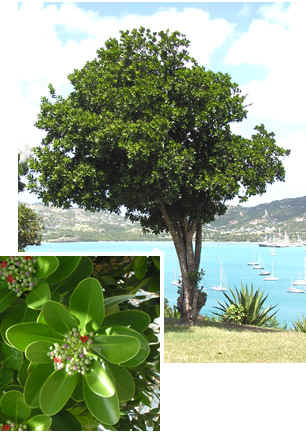 This
common tree is not
the spice bearing
plant, but Columbus
thought he had
reached the Far East
and by the sweet
odour of the bark
and leaves, thought
he had found
cinnamon, hence this
misnomer. The tree
is evergreen which
shows red berries in
winter, so is often
used as a Christmas
decoration. The
dried berries can be
used like black
pepper. The wood is
very hard and
close-grained, so
was ideal in the
making of caulking
hammers for boat
building and other
construction.
The leaves were
boiled to make an
insecticide and as a
fish poison. Fresh
leaves were placed
under mattresses to
ward off bed bugs.
This
common tree is not
the spice bearing
plant, but Columbus
thought he had
reached the Far East
and by the sweet
odour of the bark
and leaves, thought
he had found
cinnamon, hence this
misnomer. The tree
is evergreen which
shows red berries in
winter, so is often
used as a Christmas
decoration. The
dried berries can be
used like black
pepper. The wood is
very hard and
close-grained, so
was ideal in the
making of caulking
hammers for boat
building and other
construction.
The leaves were
boiled to make an
insecticide and as a
fish poison. Fresh
leaves were placed
under mattresses to
ward off bed bugs.
DO NOT USE ANY OF THESE PLANTS FOR MEDICAL PURPOSES, UNLESS UNDER EXPERIENCED SUPERVISION.
Family:
Liliaceae ,
Lilies
,
Lilies
This plant only flowers once in its lifetime, 10-20 years. Then it dies, hence another name, the Century Plant. Tequila is made from a close relative in Mexico. Rafts are still sometimes made by Antiguan youths out of the dried flower poles that sprout from the middle of the leafy rosette, February - March. Large yellow inflorescences are borne on these pole-like stems, 15-20 ft. high. This is a wonderful place to watch birds feeding. These poles are spiked together with a wooden stake as rafts for fishing inland waters – the young person’s boat. The white pulp of the fleshy rosette leaf is cut in a diamond shape to make tow-baits in trolling for fish. Other uses of the plant have been for rope, razor strops, a fire making powder, a beverage and for tuberculosis.
Family Liliaceae
This small plant with gray-green leaves easily grows on poor soils. The flower stalk rises from the middle of the leaves some 30 inches high bearing many 1 inch flowers. The plant has had so many uses in Antigua and Barbuda that it is known as 'Sinklebible', ('Single Bible'). The greatest use for the slimy interior of the leaves is for burns, including sunburn. Some of the other uses have been for ulcers, swelling, colds, asthma, worms, diabetes, increasing the appetite, an antidote for urchin spines, and conditioning the scalp. It has been used as a laxative in Carter’s Little Liver Pills. So many uses!
Family :Legume/Fabeacea
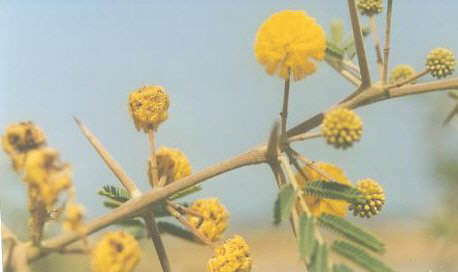 This plant that
over-runs old
cultivations and
grazing land was
introduced into
Antigua as a fuel
for the sugar
industry of the 18th
century. It is a
fast growing
hardwood with a high
calorific value. It
has made itself very
much at home here,
producing thorny
thickets. In spite
of its uncomfortable
prickles it has had
many uses: perfume,
ink, dye, glue,
tanning , tool
handles and
charcoal.
This is
similar to Acacia
tortuosa which has
one row of seeds in
its pod instead of
the two of A.
farnesiana.
This plant that
over-runs old
cultivations and
grazing land was
introduced into
Antigua as a fuel
for the sugar
industry of the 18th
century. It is a
fast growing
hardwood with a high
calorific value. It
has made itself very
much at home here,
producing thorny
thickets. In spite
of its uncomfortable
prickles it has had
many uses: perfume,
ink, dye, glue,
tanning , tool
handles and
charcoal.
This is
similar to Acacia
tortuosa which has
one row of seeds in
its pod instead of
the two of A.
farnesiana.
A Legume of
the Mimosa family - This is a native shrub or small tree with cream
white ball-like flowers and with abundant thin flat dark brown pods. The
seeds are often used for local handcrafts. It is fast growing and
common everywhere and soon takes over abandoned fields. It fixes nitrogen
from the air and can invigorate poor soils. There have been many uses in the
past, as a coffee substitute, for hoe handles, a vegetable, for tanning, a
brown and red dye, fodder, charcoal, fever, a gum, back pain and worms.
The
Caper family
This bush plant grows as a small tree and is rather attractive with its small fragrant shiny dark green leaves and white to mauve flowers. It is usually left standing in a building plot as an ornamental. The bright scarlet interior colouring of the pods was used by the Amerindians as a dye. The timber has been used as posts, hoe handles and fuel.
Of the Annonaceae
family.
A small wild native fruit tree that can withstand droughts well. Its close relative is the soursop, but the fruits are much smaller and are made up of fleshy pads which are pulled off and eaten. Drinks and sherbets are made from the fruit. Other uses of the plant, have been as an insecticide, for home remedies as for colds, flu, coughs, fever, upset stomachs. It is also as a soporific.
JUMBIE BEADS, Abrus precatorius
Small bright red seeds seen on the ground or sprouting out of their pods easily locate these vines with compound leaves. The seeds are valuable in handcrafts for making beadwork items sold to visitors. The seeds are said to be poisonous. There are many medical uses for this vine, one of them for the heart.
Family: Orchidacea
This is a native wild orchid that grows mainly on large plants out in the bush. Its little light yellow flowers on the end of long stalk, dance in the wind to delight passers-by.
Family: Rubiaceae
This bush plant is so called as the stem and branches are very straight, so was suitable for making fishing rods. In former times this plant was used as a Christmas tree and hoisted to the tops of masts of the old square-riggers as a Yuletide decoration, hence its other name ‘Upmas’, especially in the English Harbour area. The ripe berries are black, and were used as ink. The stems with the branches cut short made good hat stands. Medicinally Randia was used for coughs and colds and as an aphrodisiac. Indeed, in the Bahamas, the plant is called ‘Stiff Cock”.
Family: Polygonaceaea Buckwheats
This is a very common plant found mostly behind sandy beaches. The fruits resemble grapes, which can make a wine like beverage and jellies. They can be eaten raw. Early colonists used the large leaves as paper by scratching on a message. Other varied uses of the past and present include: wood for furniture, Carib war clubs, tanning, astringent, diarrhea and dyeing (red).
Family: Cactaceae
This common cactus is large and tall, growing to about 10 ft. high. It has many vertical limbs, branching from near the base. The dried branches make fireworks for children as they crackle and pop when burning. it was once used to celebrate Guy Fawkes Day known as 'Packing Night' (9th & 11th Nov) in Antigua and Barbuda. The cactus flesh can be used as a vegetable and as a shampoo. When the flesh is dried and powdered it can be used as a soup. The small fruits are edible, jams and syrups have been made from them. Birds often nest in the limbs, as there they are safe from mongooses. They are often left standing in land cleared for cultivation as they are difficult to remove and sometimes they are used as vegetable supports. Sterile water may be found in the stems, which leads to nibbling by goats.
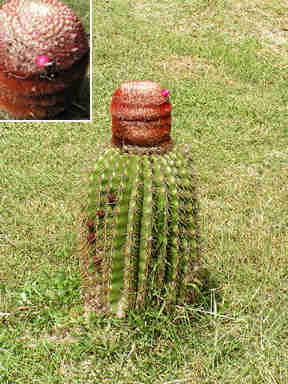
This is a barrel-shaped grotesque cactus with the wickedest of spines, easily penetrating rubber soles. It is also known in the northern islands as ‘Mother-in-law’s pincushion’. When mature it has a large red head. Its fuchsia coloured fruits are picked out of the head by birds and children. Turk’s Heads are common on rock pavement vegetation of the eastern coast, as the cliffs of Shirley Heights, (but now, believe it or not, they have been eaten by goats).They are often transplanted as ornamentals in gardens.
Family: Apocynaceae
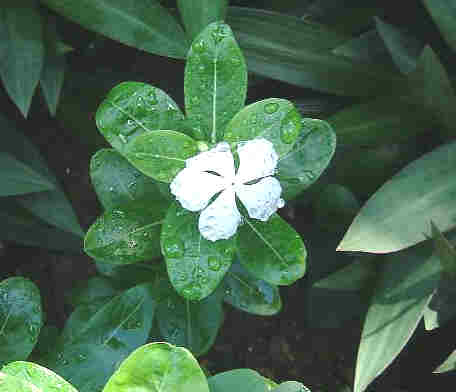
This is a common flower of wasteland. They are nearly always flowering with their large pink petals and pretty glossy foliage. C. albus is white flowered. Periwinkles are native of tropical America. Some of the medicinal uses have been for high blood pressure, strains, stomach pains, and types of leukemia, possibly cancer. The stem is boiled for diabetes taken daily, as a decoction a diuretic, lowering blood pressure. The plant can prevent primary inertia in childbirth.
Family: Compositae
This ground flower is also called Carpet Daisy. It has yellow flowers and in Antigua an unromantic name as it was placed in small children’s beds so its rough leaves would awaken them later in the night to be relieved rather than ‘pissing’ in bed. The rough leaves were also used as pot scourers. The Caribs have also used it as a tea for colds, abortion and as a poultice for sores.
Family: Legume/Caesalpineae
This is one of the most dazzling red trees of the world and is a native of Madagascar. One petal in five of each bloom is white. The visitor cannot miss it in spring at the end of the dry season. In the summer and fall the large dark brown pods cannot be missed hanging from the leafless trees. The seeds rattle within and can be used as musical shak-shaks. One leaf holds about 500 small leaflets and the tree is well adapted to drought.
Family: Nyctaginaceae
The Bougainvillea plant is named after a French navigator, Loius de Bougainville, who took a specimen back to France in 1768. It is a hardy cultigen and seems to flower in times of little rain. The brilliant colors red, (see top photo) orange, white or pink of different plants emanate from leafy bracts, while the minute flowers within, are white and have no petals. One of the first ornamentals visitors will see in house gardens. It is very common.
Family: Malvaceae
This is one of the most prevalent flowers of the tropics. Many are red, but there are 5,000 hybrids. China is thought to be the hibiscus’s native country. In the South Seas, girls wear them in their hair, as when picked, they stay fresh all day. Picked early in the day and placed in a refrigerator, they stay open all night. If you need to polish your shoes, the blossoms make a fine polish. The red blossoms make a good tea, especially if flavoured with lemon grass.
Family: Apocynaceae. The Dogbanes.
This evergreen garden shrub can have pink or white fragrant flowers. It is well planted in gardens prone to the ravages of goats, as the leaves are very poisonous. It is said that a single leaf ingested by a person can cause death and even marsh mallows or meat cooked before a fire on the end of an oleander twig can cause serious illness. The plant originates from the Mediterranean.
Family: Apocynaceae. The Dogbanes.
This shrub with yellow flowers is named after Dr. Allamand, who sent the first seeds to Linnaeus, the Swedish botanist. It has been used as a laxative, hence the scientific name. There is also a purple variety. It is a very common Antiguan garden plant.
Family: Plumbaginaceae

This is a straggling shrub with slender stems. These bear broad clusters of blue or white delicate flowers all the year round. The plant appears to like drought conditions and bright sunshinet. The root was once used as a toothpaste. There is a wild variety to be found in Antigua, P. scandens. Look for it near the boiling house at Betty’s Hope. This was once used against fevers.
Family: Legume/Caesalpineae
This is an evergreen prickly shrub with beautiful red, orange or yellow flowers with slit petals on stalks in terminal racemes. The leaves are deciduous. Very decorative hedges can be made with this plant, which loves sunshine. It has extended roots enabling it to grow in poor soil. A valuable garden plant.The flowers, leaves bark and roots have been used in home remedies.
Family: Polygonaceae
This is a very common twining vine found growing in waste places. It is almost a weed, but the pink or white flowers forming garlands are very numerous and make a conspicuous bed of colour. The leaves can be rubbed into stings to reduce swelling. A tea from the leaves can be made for diabetes and from the blossoms to treat high blood pressure. To this day, bunches of coralita are thrown on to coffins in a grave as a noise abater before the soil is filled in.
Family: Apocynaceae
This small ornamental tree is named after a French word meaning ‘coagulated milk’. The caustic milky sap that flows from a cut branch has been employed in folk medicine. It is a native of the West Indies. There is a wild bush variety, P. alba, with white flowers. It hosts a very large caterpillar of the Hawk Moth, (Pseudosphinx tetrio). The caterpillar is very conspicuous with yellow bands on black and having a red head. It feeds on the poisonous sap, thus becoming poisonous to the birds that might eat the caterpillars.
Family:
Cactaceae
This is a tall cactus very similar in appearance to the Dildo Cactus (q.v.). The branching columns grow to about 10 ft. The plant flowers several times a year, only by night, with many big, fragrant creamy-white flowers with large petals. This is a very showy plant when blooming.
Family: Euphorbaceae
This cactus-like shrub or small tree is often planted in hedges. Like other euphorbias it contains a milky white latex which is poisonous and dangerous to the eyes. The branches are numerous and very prickly hence it makes good barriers and fences. In the Virgin Islands the plant is known as Monkey Puzzle.
BATS are important to the ecology of Antigua and Barbuda and should be conserved. They are useful for insect control, seed dispersal and pollination. Many bats consume huge numbers of insects nightly. The free-tailed bats can eat several hundred insects each evening. Seven bat species are recorded from Antigua: Molossus molossus, Artibeus jamaicensis, Noctilio leporinus, Monophyllus plethodon, Brachyphylla cavernarum, Natalus stramineus, Tadarida brasiliensis.
http://biomicro.sdstate.edu/pederses/guide.html

This is probably the commonest bat of Antigua. It is an insect eater, catching insects on the run, using a kind of ‘radar’, known as echolocation, for locating them.
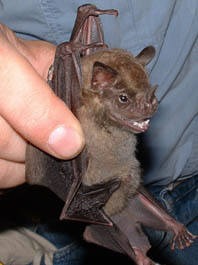
This is a bat common to tropical America. It disperses forest fruits on which it eats. It particularly fond of the fruit of the Bush Fig, Ficus benjamina of the Moracae, but this tree is rather rare in Antigua. The early Indians of the West Indies often decorated their pottery with designs based on the fruit-eating bat.
Nine mongooses were introduced into Jamaica in November 1872 in an attempt to control rats in the sugar cane fields. Unfortunately the Mongoose is a diurnal creature whereas the rat is nocturnal, so the plan did not work too well! The people at the time were very poor, so it is said that the sugar-fattened rats made good meals for them. The mongoose is slim with short legs and a tapered tail and the claws are long and sharp. The short hair is alternately banded gray and brown, which gives a speckled appearance to the fur. It is a scavenger, but eats small animals, fruits and birds. A pregnant female produces two babies that stay with mother until there is another litter.
Related to the horse, but smaller, with a tuft at the end of the tail. These animals originated from Equus asinus, the wild donkey of Abyssinia. Donkeys have long ears, which is the origin of “I haven’t seen you for donkey’s years (as they are so long!). In Antigua, the donkey was the ‘ poor man’s transport’.
A goat is hardy, lively, wanton and strong smelling. It is usually horned and bearded and ‘chews its cud’. It represents the zodiacal sign Capricorn – a licentious person, fool! In Antigua the best way of telling the difference between hardy goats and sheep is that the tails of goats go up and those of sheep go down!
This mammal is the National Animal of Antigua and Barbuda. The Fallow Deer originally came from Norway to England at the time of James I. The Codrington family introduced the first deer into Barbuda and Guana Island in the 18th century. By 1740, there were 1,000 head and by 1827 they were reported as a nuisance. The deer are not now very common, but they may still be found in Barbuda and Guana Island off the north shore of Antigua.
The Humpback is a
regular visitor to
Antigua. They may be
seen between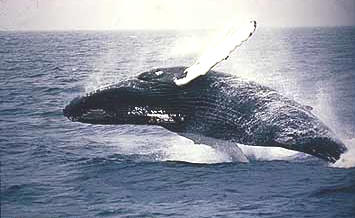 December and April
in Antiguan and
Barbudan waters.
These whales migrate
from New England to
breed in the warm
waters of the
Caribbean during
these months. The
baby whale is born
about 13 feet long
and weighs 1,000 lbs
or about the size of
a small car. Mother
weighs about the
same as six
elephants. The
juvenile drinks
about 50 gallons of
mother’s milk a day,
which is thick and
rich containing 50%
butterfat, such a
diet allows the baby
to grow about four
feet longer in three
months. The tropical
oceans contain very
little food, so
whales subsist on
the blubber attained
in winter off New
England where they
feed on shoals of
herring, squid,
small cod and
shrimp. The stomach
holds a ton of food,
often catching 3,000
lbs of fish a day.
Mother and young
then migrate back to
the Caribbean where
the baby was born.
The tail of the
adult has a black
and white pattern
and is like a
fingerprint enabling
scientists to name
and trace the
movements of the
humpback. A very
real enemy of the
Humpback is the
killer whale that
attacks in packs. In
March 2001, three of
these enemies were
reported off the
south coast of
Antigua.
December and April
in Antiguan and
Barbudan waters.
These whales migrate
from New England to
breed in the warm
waters of the
Caribbean during
these months. The
baby whale is born
about 13 feet long
and weighs 1,000 lbs
or about the size of
a small car. Mother
weighs about the
same as six
elephants. The
juvenile drinks
about 50 gallons of
mother’s milk a day,
which is thick and
rich containing 50%
butterfat, such a
diet allows the baby
to grow about four
feet longer in three
months. The tropical
oceans contain very
little food, so
whales subsist on
the blubber attained
in winter off New
England where they
feed on shoals of
herring, squid,
small cod and
shrimp. The stomach
holds a ton of food,
often catching 3,000
lbs of fish a day.
Mother and young
then migrate back to
the Caribbean where
the baby was born.
The tail of the
adult has a black
and white pattern
and is like a
fingerprint enabling
scientists to name
and trace the
movements of the
humpback. A very
real enemy of the
Humpback is the
killer whale that
attacks in packs. In
March 2001, three of
these enemies were
reported off the
south coast of
Antigua.
For Bird Watching contacts
Family Phaethontidae To TOP
This sea bird, with pigeon-like flight, most commonly seen off the North Shore Islands, grows to about 15-16”, or to include the delicate, elongated tail, up to 32”. The French West Indian name is Paille-en-queue (= Straw in tail). The wingspan is about 3 feet and the bird weighs about 1 lb. Notice a black stripe on the wings. Tropic Birds dive from a height of from 50 - 100 feet for fish, squid and they also feed on crabs. The nests may be found on bare rocks and in holes on the edge of cliffs. One egg is laid, which is pinkish and speckled. The young fly about 62 days after hatching. Though graceful in flight they shove themselves on the breast along the ground as the legs are so far back. Adults utter a cry of “Kareek, keek, kark”. The Red-billed Tropic Bird may also be seen. It has narrow black bars across the back and a part of the wings.
Family Pelecanideae
A familiar bird of the tropic seashore, known in Antigua and Barbuda as ‘Booby’. Of graceful flight, they may be seen skimming within inches of the water in single file. They may also be observed diving from a height of a 60 - 70 feet. Air sacs under the skin, cushion the impact of steep dives, and bring then up like a cork, always facing the wind, ready for take-off. The large bills act as scoop-nets.
Pelicans appear to be on the decline, because of such hard pesticides as DDT and dieldrin found in the marine food chain. This causes the eggshell to be thin, and the eggs break in the nest.
Nests are built on top of mangroves or on the ground. The eggs are chalky white, but they soon become soiled with guano. Pelicans fly at 26 mph and they are voiceless. The pelican has been adopted as the crest of the University of the West Indies.
Family Fregatidae
These
large graceful sea
birds, with forked
tail and angular
wings, widespread in
the tropics, may be
seen soaring
effortlessly against
the blue of the
tropic sky. It is
indeed a magnificent
bird, as its
scientific name
suggests.
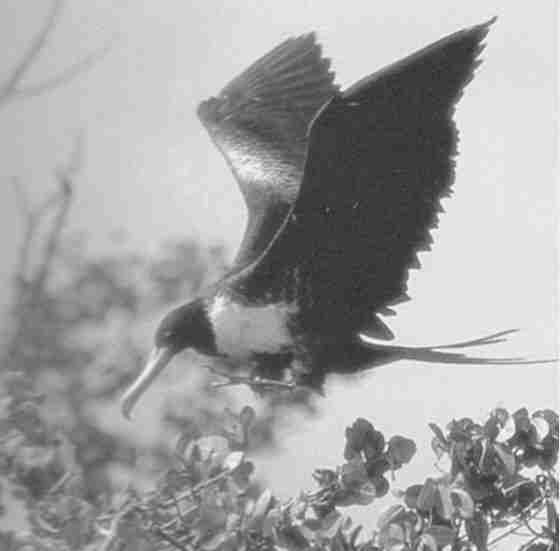
Barbuda boasts the largest Frigate breeding and nesting colony in the world. It is a tourist attraction, for the birds do not appear to mind visitors and allow close-up photography. Males are glossy black, and when courting they display a bright red pouch. Females are larger, with the sides and breast white. In Antigua and Barbuda, they are known as ‘Weather Birds’, as on the approach of a storm they may be seen circling inland.
Adults have a length of just over 3 feet and a wingspan of from 7 - 8 ft. and weight of about 3 lbs. With this wing-span/weight ratio, the birds appear to ‘hang’ in the sky, for they are great soarers. In a flat calm, Frigates are known to fly at 22 mph.
Fishermen use them to locate schools of fish as they may be seen circling and diving over schools of fish. They dive for albacore and flying fish, but also eat jelly fish, crustaceans and young turtles. They rob other seabirds of their newly caught food, hence their name of Frigate or Man-o-War.
The birds attain an age of between 5 - 7 years before the first breeding. Flat nests of twigs and grasses are built. One white egg per nest appears from mid-September until late March. The young are fed by regurgitation and the young fly from 149 -207 days after hatching. They sleep so soundly that it’s possible catch them with bare hands; this must have been a blessing for the Amerindians, when hunting for food. The Indian name for them was ‘Manor’. A frigate bird has been recorded as having reached the ripe old age of 34 years.
Family Ardeidae
This is the only heron that is not a wader, usually being found in grassland in association with cattle. The species name is the name of the sacred Egyptian bird. These egrets have a wingspan of about 3 feet and are about 20 inches tall. They weigh about 12 oz.
This is a common Antiguan bird often seen perched on the backs of cattle, waiting for grasshoppers and other insects on the ground roused as cattle walk and graze. They also eat spiders, frogs and crickets.
Egrets were self-introduced from Africa to the Western Hemisphere, probably being scattered by storms. The first were seen in South America about 1887-92, but were reported in the Caribbean from 1933. Now they can be seen as far north as Canada.
Cattle Egrets nest in colonies of between 200-300 birds in Antiguan and Barbudan mangroves. Every evening they are seen in flocks going to these colonies to roost. In mating time the males gather twigs and the females build the nests, at the same time warding off thieving birds. Two to six light blue eggs are laid which take about 22 days to incubate. This is the only heron able to breed in its first year. The birds are silent except for a croaking sound in nesting season. The young are able to fly reasonably well in 60 days and off they go!
Family Anatidae
Latin: Dendron=a tree. Cygna= a swan arborea=tree habitat
This 20 inch uncommon resident, the West Indian Whistling Duck is a long-necked brown duck with a dark streak from the top of the head down the neck. It is found in mangroves and near ponds perching high in trees. A famous locality is on Guana Island off the north-eastern shore of Antigua.
This bird is largely nocturnal, often seen flying over swamps at dusk. It feeds on the fruit of palms and it is rarely seen swimming on water. The Whistling Duck utters a shrill whistled visisee. It commonly nests amongst water plants in the ground or in a cavity of a tree or in a cluster of bromeliads high above the ground. It lays about10 milky white eggs and incubates in a month.
Family: Accipitridae (Hawks)
This large uncommon Antigua and Barbudan resident is a 24 inch long sea hawk. It is black with a white head and undersides, and was named after Pandion, the King of Athens, father of Philomena and Procne. This bird winters in South America and Mexico and migrates north in spring through the Caribbean as far north as Canada and Alaska. Solitary birds may be seen perched in the mangroves at English Harbour, Indian Creek and other localities in spring, spotting for fish. They also fly between 30-100 ft hovering over a school of fish ready to dive. It is said they can catch fish in the talons up to 4 lbs. The catch is then eaten at leisure in a habitual perch or taken to a nest to feed young or sitting female.
Nests are often built in dead trees near the water in North America, built of sticks, seaweeds, driftwood or other trash from wetlands. The nests can weigh up to half a ton. Nests are used year after year for decades. Three pink to white eggs, heavily blotched and spotted with browns, are laid. The young hatch after about a month and the young make first flights after about eight weeks and return to their nests.
Ospreys have been known to live up to 32 years and they fly about 27 mph. The maximum weight is about 3lbs 8 oz.
Family: Columbidae, Pigeons

A very common bird found on the ground searching out grass seeds. They are very well camouflaged in brown. The ground dove is a small bird six to seven inches long. The call is a whoop or perwhoop uttered two to twenty four times. They are quite tame on approach and nest on or near the ground.
Fairly common in
Antigua and may be
often seen near
Pigeon Beach on
Middle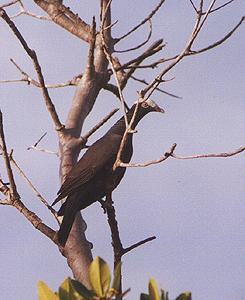 Ground. This
is a large (15 inch)
dark pigeon except
for the bright white
crown from forehead
to nape. The bill is
yellow and the eyes
are white. These
pigeons eat berries,
seeds and some
insects. It utters
as a call - wof,
wof, woo, co-woo
in a rather owl-like
fashion. One or two
glossy white eggs
are laid in a
compactly built nest
of twigs, lined with
fibrous roots and
grasses. Sometimes
the nests are found
in mangroves, in the
bush or on the top
of a cactus.
Ground. This
is a large (15 inch)
dark pigeon except
for the bright white
crown from forehead
to nape. The bill is
yellow and the eyes
are white. These
pigeons eat berries,
seeds and some
insects. It utters
as a call - wof,
wof, woo, co-woo
in a rather owl-like
fashion. One or two
glossy white eggs
are laid in a
compactly built nest
of twigs, lined with
fibrous roots and
grasses. Sometimes
the nests are found
in mangroves, in the
bush or on the top
of a cactus.
Family: Trochilidae Hummingbirds
Here are some wonderful photos of a Hummingbird nest and the hatching of eggs ....
http://community-2.webtv.net/hotmail.com/verle33/HummingBirdNest/
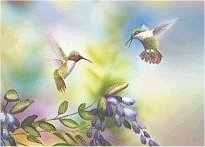 This is the
commonest
hummingbird of the
islands. The larger
Green-throated
hummingbird has no
crest. In Antigua,
the name ‘Doctor
Brushy’ is given.
Because of their
size, hummingbirds
have the highest
rate of metabolism
(‘burning’ of food)
of a warm-blooded
vertebrate in the
world. As a result,
they have to feed
nearly all day long.
They have long
curved beaks with
witch they probe
into flowers for
nectar and
fertilizing the
flower at the same
time. Besides flower
nectar, humming
birds feed on
insects, mainly from
the plants they
visit. The best
place to watch
hummingbirds is on a
flowering Dagger
Tree. The female
builds a small nest
that is lined with
cobwebs or some
other fluff. Two
very small white
eggs are laid. These
smallest of birds
can live up to at
least 10 years (if a
picture window does
not get in their
way!).
This is the
commonest
hummingbird of the
islands. The larger
Green-throated
hummingbird has no
crest. In Antigua,
the name ‘Doctor
Brushy’ is given.
Because of their
size, hummingbirds
have the highest
rate of metabolism
(‘burning’ of food)
of a warm-blooded
vertebrate in the
world. As a result,
they have to feed
nearly all day long.
They have long
curved beaks with
witch they probe
into flowers for
nectar and
fertilizing the
flower at the same
time. Besides flower
nectar, humming
birds feed on
insects, mainly from
the plants they
visit. The best
place to watch
hummingbirds is on a
flowering Dagger
Tree. The female
builds a small nest
that is lined with
cobwebs or some
other fluff. Two
very small white
eggs are laid. These
smallest of birds
can live up to at
least 10 years (if a
picture window does
not get in their
way!).
Family: Tyrranidae Flycatchers
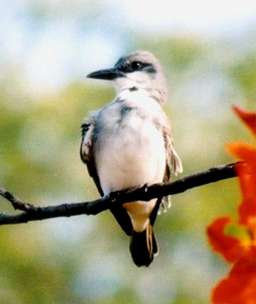
This is another of the commoner birds of Antigua usually about 9 inches long. It is ghostly grey above and light underneath, and has a large bill and a black eye streak. The Antiguans know the bird as ‘Loggerheads’. They may often be found bordering lawns perched on a tree spotting for grasshoppers and other insects passing-by, the latter being caught in mid-air. A dive will suddenly be made and an audible click is heard as the victim is caught. Then the bird returns to its original perch. A flimsy nest is built in trees and made of slender twigs and grasses. Three or four white eggs spotted with brown are laid.
Family:Icteridae Troupials
This is a common resident of Antigua and one that can be fairly easily tamed. The Grackle is a very bold bird that lands on visitor’s hotel dining room tables. They are glossy black birds with a long black beaks and bright yellow eyes. The tails are long and wedge-shaped tails held in flight like a V. Grackles utter a very noisy squawk (chawk) and can be very noisy in flocks. Untidy nests are made of twigs and sometimes lined with mud. Five or 6 light brown eggs are laid with blotches and streaked with lines, dashes of brown and lavender. The period of incubation is two weeks and the young are off after about 19 days. Grackles live to be about 15 years old and they fly about 25 mph.
Family: Coerebidae, Honeycreepers
This is a very common small, 4-5 inch bird, found near homes and hotels. They entertain guests at breakfast by alighting on tables to steal sugar. They are known as ‘Sugar Birds’ or ‘Yellow Breasts’ locally. The race in Antigua has a red mark just behind the bill, which is curved and used for obtaining nectar from flowers. They also eat fruit and insects. Bananaquits build untidy globular nests with a side entrance and are also used for roosting at night when the female is not sitting on eggs.
Family: Ploceidae Finches
This is the very common sparrow-like bird that is almost black with a rufus breast. In Antigua this bird is known as the ‘Red Breast’ or ‘Robin’. The bird may be found commonly and remarkably tame in the gardens of Antigua. They will even venture into houses. They feed on seeds, breaking the shells with the strong beak. Two or three spotted eggs are laid in an untidy globular nest with a side entrance built in a tree or large bush.
Family: Ploceidae Finches
This is a small four-inch dark greenish-tinged bird with a short tail commonly found on lawns searching out seeds. The female is lighter all over. The song is a buzzing tik-zeee or tik-tik-zeee. A globular nest with a side entrance is built near the ground, in which three spotted eggs are laid.
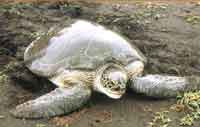 This is the
commonest sea turtle
of Antigua, but they
are an endangered
species. Hawksbills
have a narrow
pointed beak and the
shell is jagged
towards the rear.
The shell is
beautifully mottled
brown, orange and
gold, so is prized
for handcrafts.
Earrings, combs,
jewel boxes were
made, but now this
is illegal. This
species is not as
good eating as the
Green Turtle.
Hawksbills grow to 3
ft. long and weigh
175 lbs and the main
diet is of sponges.
The largest nesting
concentration of
Hawksbills is on
Long Island off
North Sound. Eighty
to a hundred females
lay four to five
hundred nests around
Antigua and Barbuda,
nesting 4-6 times a
year at 15-day
intervals. 18,000
hatchlings are
produced a year,
with only about 3%
reaching adulthood.
Hawksbills live to
about 50 years if
not taken by
fishermen. In 1892,
the Globe Hotel in
St. John’s had the
best Hawksbill soup.
The early Indians of
Antigua perceived
the Hawksbill as “a
gift from the Gods”.
The turtle motif is
often found on their
pottery as incised
designs or as
sculptured handles.
This is the
commonest sea turtle
of Antigua, but they
are an endangered
species. Hawksbills
have a narrow
pointed beak and the
shell is jagged
towards the rear.
The shell is
beautifully mottled
brown, orange and
gold, so is prized
for handcrafts.
Earrings, combs,
jewel boxes were
made, but now this
is illegal. This
species is not as
good eating as the
Green Turtle.
Hawksbills grow to 3
ft. long and weigh
175 lbs and the main
diet is of sponges.
The largest nesting
concentration of
Hawksbills is on
Long Island off
North Sound. Eighty
to a hundred females
lay four to five
hundred nests around
Antigua and Barbuda,
nesting 4-6 times a
year at 15-day
intervals. 18,000
hatchlings are
produced a year,
with only about 3%
reaching adulthood.
Hawksbills live to
about 50 years if
not taken by
fishermen. In 1892,
the Globe Hotel in
St. John’s had the
best Hawksbill soup.
The early Indians of
Antigua perceived
the Hawksbill as “a
gift from the Gods”.
The turtle motif is
often found on their
pottery as incised
designs or as
sculptured handles.
This is the second commonest turtle after the Hawksbill, but this turtle is also endangered. It was a very common turtle 400 years ago, but now it is almost extinct, as it has been ‘eaten out’, since it was a great delicacy. This turtle feeds on sea grass found in shallow water. It has a round blunt beak with serrated cutting edges. The shell colour is light to dark brown. Adults attain the weight of 500 lbs, and generally measure 40 inches average. Nesting has been reported on more than 20 Antiguan beaches. Each female probably lays two to six clutches of eggs (of 125-150) every 2-3 years. It is estimated that sexual maturity is attained after 27-33 years.
This species has long lived in Antigua having been introduced by the Indians and later by the European settlers, giving a universal distribution in the West Indies. The early canoe seafarers used land turtles as fresh meat for their long sea voyages, and indeed they are still eaten as a delicacy. These vegetarians grow to be very old and reach up to about 12 ins. in length. Land turtles or tortoises, as they are often called, can live long periods without food or water. They are quite often kept as pets. They are commoner in Barbuda’s bush than in Antigua.
 This is a common
nocturnal lizard
found in dark
places. It likes to
live behind pictures
in houses. Woodslaves are
beneficial, as they
eat mosquitoes,
flies, ants, roaches
and spiders about
the house.The
only disadvantage is that they make large white droppings on furniture.
This is a common
nocturnal lizard
found in dark
places. It likes to
live behind pictures
in houses. Woodslaves are
beneficial, as they
eat mosquitoes,
flies, ants, roaches
and spiders about
the house.The
only disadvantage is that they make large white droppings on furniture.
This lizard’s toes are dilated enabling the creature to walk on ceilings. The colouring is dark brown and they are capable of making a loud call. Amerindians considered these ugly lizards malevolent spirits and their name for them was ‘mabouia’, the species name today.
Their small white, hard shelled eggs can often be found behind books in bookcases or other dark corners. Their short round tails can drop off when attacked and later regenerate.
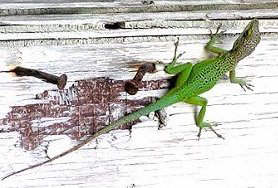 This is the common
lizard that changes
colour so readily
and blows out the
red throat dewlap
when courting.
Anoles are territorial and the dewlaps are also used as a threatening signal to
other males.
It
has been found that
Anole
lizards are
green when active,
turning to a medium
brown when reposing.
Females mature at 1.5 ins taking at least 9 months. Males mature at 2 inches.
When fully grown Anoles reach five or six inches. As they grow, they shed their
old thin skins which they eat.
This is the common
lizard that changes
colour so readily
and blows out the
red throat dewlap
when courting.
Anoles are territorial and the dewlaps are also used as a threatening signal to
other males.
It
has been found that
Anole
lizards are
green when active,
turning to a medium
brown when reposing.
Females mature at 1.5 ins taking at least 9 months. Males mature at 2 inches.
When fully grown Anoles reach five or six inches. As they grow, they shed their
old thin skins which they eat.
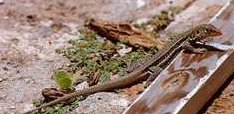 This is smaller than
the Green Tree
Lizard; the colour
is brown or bronze.
It is a very common
Antiguan lizard and
may even been seen
in houses catching
flies and small
moths near windows.
The Amerindians
originally
introduced it from
South America.
This is smaller than
the Green Tree
Lizard; the colour
is brown or bronze.
It is a very common
Antiguan lizard and
may even been seen
in houses catching
flies and small
moths near windows.
The Amerindians
originally
introduced it from
South America.
This 10-inch dark brown lizard with a reddish head may often be seen scrabbling on the ground of scrubby vegetation, making quite a noise in dead leaves. It feeds on insects, scorpions, spiders and roaches and even small bird eggs. These lizards do not climb trees, but confine themselves to rocks and the ground. There are 19 species of Ground Lizard. RACER SNAKE, Alsophus antillensis antiguae
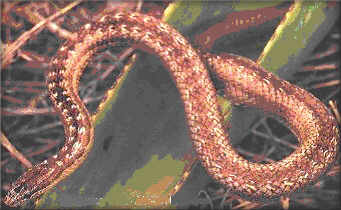 This small smooth
brown snake (the
only known in
Antigua) is also
called the Ground
Snake. In the entire
world it is only
found on Great Bird
Island, where the
Environmental
Awareness Group (EAG)
protects it. There
are about 120
individuals, which
are being brought
back from the brink
of extinction.
In 1995, the EAG
along with other
regional and
international
organisations Fauna
and Flora
International UK,
The Antigua Forestry
Department, Jersey
Wildlife
Preservation Trust
and Island Resources
Foundation) embarked
on the Antigua Racer
Conservation Project
(ARCP). The ARCP
aims to conserve the
critically
endangered Antiguan
racer snake (Alsophis
antiguae), and
its natural
habitat.
Additionally, it
aims to enhance
biodiversity
conservation efforts
in Antigua &
Barbuda, with
particular focus on
the offshore islands
of Antigua.
This small smooth
brown snake (the
only known in
Antigua) is also
called the Ground
Snake. In the entire
world it is only
found on Great Bird
Island, where the
Environmental
Awareness Group (EAG)
protects it. There
are about 120
individuals, which
are being brought
back from the brink
of extinction.
In 1995, the EAG
along with other
regional and
international
organisations Fauna
and Flora
International UK,
The Antigua Forestry
Department, Jersey
Wildlife
Preservation Trust
and Island Resources
Foundation) embarked
on the Antigua Racer
Conservation Project
(ARCP). The ARCP
aims to conserve the
critically
endangered Antiguan
racer snake (Alsophis
antiguae), and
its natural
habitat.
Additionally, it
aims to enhance
biodiversity
conservation efforts
in Antigua &
Barbuda, with
particular focus on
the offshore islands
of Antigua.
 This large toad
of
about 8 inches and
weighing nearly 2
lbs cannot be missed
by this size and by
its distinctive
call.
However it can
sometimes be missed
by virtue of its
clever colouring
making it blend into
its background.
It is an introduced
species supposed to
deal with vermin in
agricultural fields
as they feed on
insects. Beetles and
ants are the
favourites. These
toads are
common at certain
localities in and
after damp weather
and near ponds. They
dry out easily and
search for dark
places during the
day, even visiting
houses. Quite often
they may be seen
cooling off in the
dog’s drinking
water!
This large toad
of
about 8 inches and
weighing nearly 2
lbs cannot be missed
by this size and by
its distinctive
call.
However it can
sometimes be missed
by virtue of its
clever colouring
making it blend into
its background.
It is an introduced
species supposed to
deal with vermin in
agricultural fields
as they feed on
insects. Beetles and
ants are the
favourites. These
toads are
common at certain
localities in and
after damp weather
and near ponds. They
dry out easily and
search for dark
places during the
day, even visiting
houses. Quite often
they may be seen
cooling off in the
dog’s drinking
water!
These are the smallest organisms with the longest of names. They are responsible for the chirping sounds heard at night, and become very noisy after a shower of rain. The early Indians, the Arawaks, carved beautiful pendants in their likeness, in the hope that rain would fall to nourish their crops. The frog was considered a benevolent spirit.
The
Tree or Piping Frog is found in a dry, mesic and rain forest environment, where
the
population density is
about 8,100 per acre. They grow to about 2 inches in length and the appearance
is vari able.
The frog lives in leaf litter by day and rises to a higher elevation by night
where it feeds, calls and mates.
able.
The frog lives in leaf litter by day and rises to a higher elevation by night
where it feeds, calls and mates.
The food consists of insects, snails and small frogs. It has been estimated that this genus of frog consumes about 46,000 prey items per night per acre in a rain forest.
The call is loud at 90-100 decibels, 1.5 ins from the frog. It is a short single rising note. By the way, the relative, E. coqui of Puerto Rico, has a two note, high pitched call, "co-qui". The sounds in the night made by these frogs have been the subject of complaints from our visitors!
The eggs are laid in leaf litter and there is no tadpole stage. The eggs hatch in 2-3 weeks and the generation time is eight months.
The long slender bodied Wahoo is a fine sport fisherman’s catch. It makes fast runs and changes direction when hooked and leaps clear of the water. The average size is about 15 – 20 lbs.
Barracuda can grow very large, perhaps up to 6 ft. and 106 lbs. They are not dangerous fish as thought by many. Swimmers in Antiguan waters have recorded no attack. They look very fierce with a large tooth showing outside their lips. They feed on other smaller fish; they usually they circle their victim first before attacking. Commonly caught near reefs when trolling, and often seen by reef snorkelers. The flesh of large specimens in Antigua can be toxic with ciguatera.
The Albacore can be distinguished from the Bluefin and other tuna as the dorsal fin extends beyond the anal fin. This fish can grow up to about 95 lbs., but they are commonly much smaller. The Albacore is a good sport fish.
This fish is not to be confused with the mammalian porpoise-like dolphins. It is a truly beautiful fish of many colours and a good sport fish as it puts up a tremendous fight, when hooked, making fast powerful runs and leaping clean out of the sea. This is a very good eating fish and sold under its Hawaiian name, mahi mahi. Dolphins feed mainly on flying fish living in open oceanic waters. The fish grows to about 90 lbs. The heads of female dolphin fish are more rounded than the heads of adult males.
This is an abundant fish found near reefs. It is both diurnal and nocturnal and feeds on zooplankton. It is a silvery fish with a yellow strip along its body all the way to its tail. This highly esteemed food fish reaches a length of about 30 inches.
This 14-inch snapper is most gregarious and forms schools on grassy bottoms. There is a black dot midway along the back among its pink and yellow horizontal stripes. This snapper is found in shallow waters throughout the tropical West Atlantic. It is delicious to eat. There are many different species of snapper in Antigua, the Red and Silk Snapper among them.
There are several species of grouper found in Antigua’s waters. There is the Nassau Grouper, the Red Hind and Rock Hind and more. They are a solitary fish living near rocks, wrecks and piers in coastal waters. They are robust and sharp toothed, living near the bottom and feeding on small fish, crustaceans and shellfish. They change sex as they grow; firstly they become females, but turn into males, as they grow older.
This is the most beautiful reef fish of the Western Atlantic. It is a ‘vertical’ fish of many blues, yellows and greens. The Queen Angelfish has a ‘crown’ marking above its eyes. It grows to about 10 ins., and is a sponge eater liking different species. Juveniles apparently clean parasites off other fish.
A coral reef fish. Grunts are named after the sound they make when they grind their teeth together. They are a diurnal fish and are gregarious.
This is a common seven-inch diurnal and gregarious reef fish and found in shallow water. They feed on zooplankton, algae and smaller invertebrates. The female glues eggs on to a cleaned off rock and the male guards the nest for 2-3 days, having turned a dark blue. This fish is so named after the dark stripes on the yellow body.
This is not a true lobster with claws. It is in fact, a member of the crayfish family. They would grow to about 24 inches long but they seldom attain that size as they are delicious to eat and are becoming very scarce. Lobster dishes may be found on the menu of various hotels, though nowadays ‘at a price’. Scuba fishermen dive deeply for them and sometimes get the bends as dive tables are not adhered to properly. These crustaceans seek shelter in dark caves within coral reefs during the day and venture forth at night in search of molluscs and other invertebrates.
This yellow/brown species is the most common coral. It is found in the upper zone of a reef most commonly, though it occurs in all zones. The broad flat branches’ orientation is controlled by current and light.
There are several other Brain Corals from Antigua, viz. Giant Brain Coral, Colpophylla natans, Knobby Brain Coral, Diploria clivosa, the Grooved Brain Coral, Diploria labyrinthiformis and the Smooth Brain Coral. The latter grows from about 3 to 45 feet, and is fairly common on a bank barrier reef.
The White Sea Urchin is covered with short white spines. They live on reefs in shallow water and often cover themselves with sea grass as a camouflage. The mouth is below and five teeth scrape algae off the reefs. Waste material is exhausted at the top. White Sea Urchins are considered a delicacy in the West Indian islands as the gonads (eggs) are eaten raw with lime and sometimes roasted over a fire. The dish has a great taste of the sea. The species has thus become over exploited and is scarce in some places.
These are common on grassy bottoms near the seashore and on reefs; they are beginning to reappear after a mysterious disease that spread in the Gulf Stream from 1983. The cause was thought to have been a pathogen rather than a pollutant. These 15-inch urchins (including the long spines) have black brittle spines that break off into enemies. People who accidental brush them should use an antiseptic or ammonia (urine will do!) to dissolve the spines that have entered under the skin. Do not cut them out.
This crustacean that lives in long curved burrows in the mud of mangrove swamps is also called the White Crab. They are of a light yellow, grey or blue-grey colour. They only leave their burrows at night or when it is raining for they easily ‘dry out’. Land crabs are purged in captivity with coconut or cornmeal before eating. The meat is put in its carapace and baked to make a dish known as ‘crab back’. In Antigua people go ‘torching’ which means taking an old beer bottle, filling it with kerosene and placing a rag in its mouth (a wick) and lighting it to make a torch attracting land crabs by the light.
These hermit crabs may be seen crawling with their borrowed seashells serving as ‘houses’ far from the ocean. They live most of the time in inland forests, they only return to the sea to lay their eggs. The young become members of the plankton before they finally take up life on dry land. The West Indian top shell appears to be the popular ‘house’ for hermit crabs. As they grow they have to search out new shells. It is quite a performance choosing the right shell by feel, and then they quickly change into the new house before fellow cannibalistic crabs, which might well want that shell, eat them! Hermit’s soft bodies are well sought after by fishermen as fish bait. These crustaceans are not fussy about their food as they are scavengers, eating plants, carrion and even the poisonous manchioneel apple.
This is the species of sea moss that grows in Antigua. Gracilaria is the kind grown in other islands. Sea moss is the term given to edible seaweeds. Sea moss is collected or farmed and used for food in the Caribbean. It is said to be an aphrodisiac, thus tends to sell well. Drinks, porridge and puddings are made from these plants and are famous as revitalising tonics. These drinks have a thick consistency; a substance called carrageenan is responsible for this. It is also used in processing foods, for example, in milk products. The trade is mainly based on dried sea moss that has been bleached by washing it and drying in the sun.
This is a heavy 2 – 4 inch shell splotched black and white and found very commonly on rocky seashores and in Amerindian middens. It is also a favourite shell of the Purple clawed hermit crab, Coenobita clypeatus. Delicious chowder may be made from this mollusk. The Amerindians knew these molluscs as ‘burgao’.
This oyster is edible, though meagre, growing on mangrove roots. About 28,000 lbs of these shells were once harvested a year in Puerto Rico. This mollusc lays very small eggs, about 50 million at a time. They hatch and form part of the microscopic drifting life of the seas called plankton.
This 2 - 3 inch bivalve, tan coloured with flecks and zebra striped marks of reddish-brown, is very common. It may be found attached to rocks of the seashore. The hinge of this shell is perhaps the straightest line found in nature. It is common in Amerindian middens, (garbage dumps).
There are several species of chitons or coat-of-mail shells found in Antigua. This common one is about 2 to 3 inches long and is brown with granulated sculpturing. It has a thick black and white fuzzy mantle. This species may be found just below the high tide mark on and under rocks.
 These are the large
shells (up to 10
ins) often seen
decorating people’s
gardens. When newly
captured they have a
pretty pink
interior.
Unfortunately this
mollusc is becoming
scarce as conch is a
favourite nutritious
West Indian food and
so easy to dive for
on sea grass beds on
which this species
feeds. They are
definitely
overexploited, even
more so with the
advent of island
scuba divers who
search them out in
the depths. The
female lays a
cluster of half a
million eggs, but
the survival rate is
not great as the
hatched juveniles
are eaten by other
sea life when in the planktonic stage.
Conchs can live up
to 25 years. The
Amerindians also
exploited this shell
and used it to make
sharp hand adzes
with which to hollow
out their canoes.
Their middens (piles
of shells) may be
seen at various
locations around
Antigua. There is
one on a small
island in Nonsuch
Harbour.
These are the large
shells (up to 10
ins) often seen
decorating people’s
gardens. When newly
captured they have a
pretty pink
interior.
Unfortunately this
mollusc is becoming
scarce as conch is a
favourite nutritious
West Indian food and
so easy to dive for
on sea grass beds on
which this species
feeds. They are
definitely
overexploited, even
more so with the
advent of island
scuba divers who
search them out in
the depths. The
female lays a
cluster of half a
million eggs, but
the survival rate is
not great as the
hatched juveniles
are eaten by other
sea life when in the planktonic stage.
Conchs can live up
to 25 years. The
Amerindians also
exploited this shell
and used it to make
sharp hand adzes
with which to hollow
out their canoes.
Their middens (piles
of shells) may be
seen at various
locations around
Antigua. There is
one on a small
island in Nonsuch
Harbour.
These small three-inch conchs may be found feeding on grassy areas from about 6 to 50 feet. They have a glossy, golden colour of the body and aperture, though this colour can vary considerably from cream-orange to salmon-pink.
This is a very pretty spiny three-inch shell, cream to dark brown, 3 – 6 inches long. It is a common species and may be found on the roots of mangroves where it feeds on oysters.
This is a good name for this periwinkle as its shell has several rows of small rounded white beads. This is a very common shell clinging to rocks well above the high water mark.
This is a small limpet with a small hole in its apex. It is 1 – 1.5 inches in length with radiating ribs, the edges are deeply serrated. The colour is white to brown and the interior is white. It is common found clinging to rocks between the high and low tide marks.
This is a pretty gastropod, quite often seen washed ashore. It is 1.5 to 4 inches long and is coloured with brown squares on a creamy-white background. The outer lip is thickened and is quite well serrated.
This shell is a white bivalve with yellow or rose near the hinge. It is rather rounded and about 3 inches in size. It is commonly found washed ashore where the bottom is of a sandy mud in calm water.
This is a beautiful white shell with radiating pink rays that used to be common on Pigeon Beach, but now we are afraid only bottle tops are found! Tellins live in shallow sandy bottoms.
This Vase belongs to the Xancidae family and is endemic to Antigua and Barbuda, where it is fairly common at certain localities. Good places to start looking are at Windward Bay in Antigua and Spanish Point in Barbuda. A member of Dr. Nutting’s Iowa Barbados-Antigua Expedition (1918) first described this species in 1919. Groupers are inclined to eat them at high tide.

This large dark four lunged hairy spider lives in burrows underground. They do not weave webs, but instead line their burrows with a silky substance. They are nocturnal and pounce on their prey that includes moths and grasshoppers. They can sting a person, but the bite is not serious, their bristles and looks are more troublesome! Some call this arachnid ‘tarantulas’ but this must not be confused with the European Tarantula. Locally they are called ‘Money spiders’. These spiders have been kept in captivity for 20 years.
CICADA of the Cicadidae family
This insect is responsible for making one of the many sounds of night. The Cicadas have a stout body, a wide blunt head, and large transparent membranous wings. They are sometimes erroneously called Locusts or Harvest flies.
Cicadas are noted for their long shrill notes made by the male insect, produced by vibrating membranes of special sound organs on the underside of the abdomen called tymbals. Each kind of Cicada has its own distinctive song, sung with a deafening gusto. The song appears to be thrown in a different direction from the listener, rather like a ventriloquist.
Cicadas are plant sap feeders with piercing and sucking mouthparts.
The larvae live underground, feeding on roots, and some species require a long period to develop.
This beetle glows with a cold light that flashes as a mating response. The yellow-green light is given off by the oxidation of lucerin. The light is controlled by regulating an air supply to the light-producing organ. Fireflies may be seen after a wet spell flitting about in wooded areas.
Termites do untold damage to West Indian houses or anything of wooden construction. They can digest wood, but termites receive help from a certain organism that live in their stomachs. These insects have a thick waist and a straight antenna. The worker is blind and sterile. It lives in the ground and comes up in tunnels to attack wood. It feeds the underground colony. The soldier looks like the workers but has a long head with large jaws with which it fends off enemies, the common ant. The queen is brown or black with a thick waist. Her duty is to lay eggs. Young queens swarm in spring and disperse to start new colonies.
There are no native honeybees from Antigua. The common bees were introduced from Europe in the late 18th century. Antigua produces fine honey. Some is collected from the old sugar mill towers and there are several bee farms.. The main honey plants of Antigua are the Logwood (Haematoxylum campechianum), Cossie (Acacia farnesiana), Dumps (Ziziphus Mauritania), Genip (Melicoccus bijugatus), Mango (Mangifera indica), Coconut tree (Coco nucifera).
HAWK MOTH, Pseudosphinx tetrio
Frangipani Caterpillar
This large dark silvery-gray moth pupates from the ground under the wild
Frangipani Tree (Plumieria alba) and sometimes from under Allamandas
(Yellow Bells), also belonging to the Apocynaceae family.
The caterpillar is large, about 5
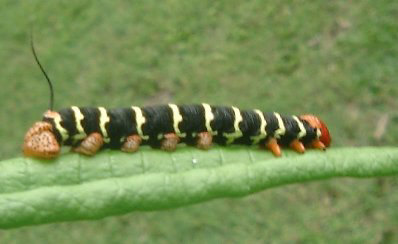 inches
long, and as fat as a finger. They are very conspicuous with yellow bands on the
black body and has a red head, presumably as a warning signal to birds. They
feed on the poisonous sap, thus becoming poisonous to the birds that might be
searching for food. After the leaves are stripped by the voracious caterpillars
then bury into the ground to pupate. This cycle is said to be of much use to
each party, so they thus live in a symbiotic relationship.
inches
long, and as fat as a finger. They are very conspicuous with yellow bands on the
black body and has a red head, presumably as a warning signal to birds. They
feed on the poisonous sap, thus becoming poisonous to the birds that might be
searching for food. After the leaves are stripped by the voracious caterpillars
then bury into the ground to pupate. This cycle is said to be of much use to
each party, so they thus live in a symbiotic relationship.
Page updated D. V. Nicholson, 8 March 2005.